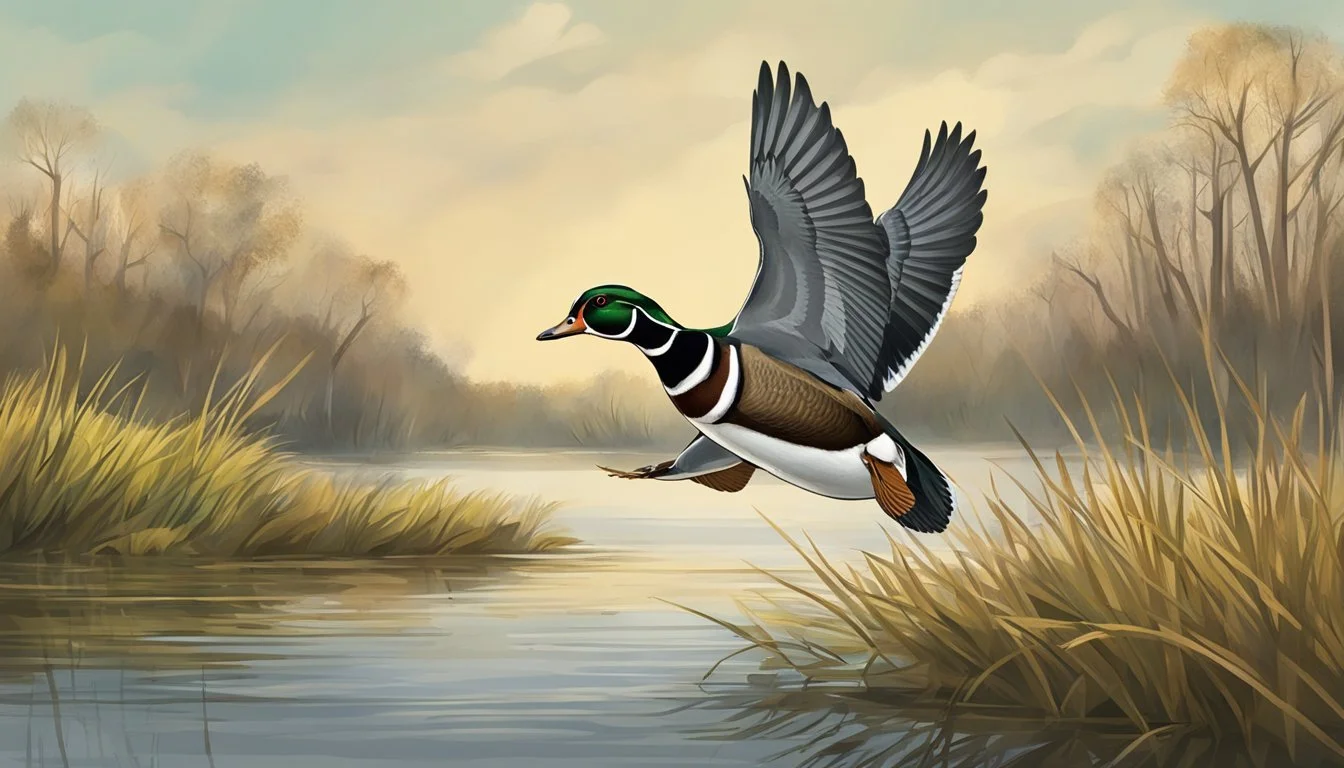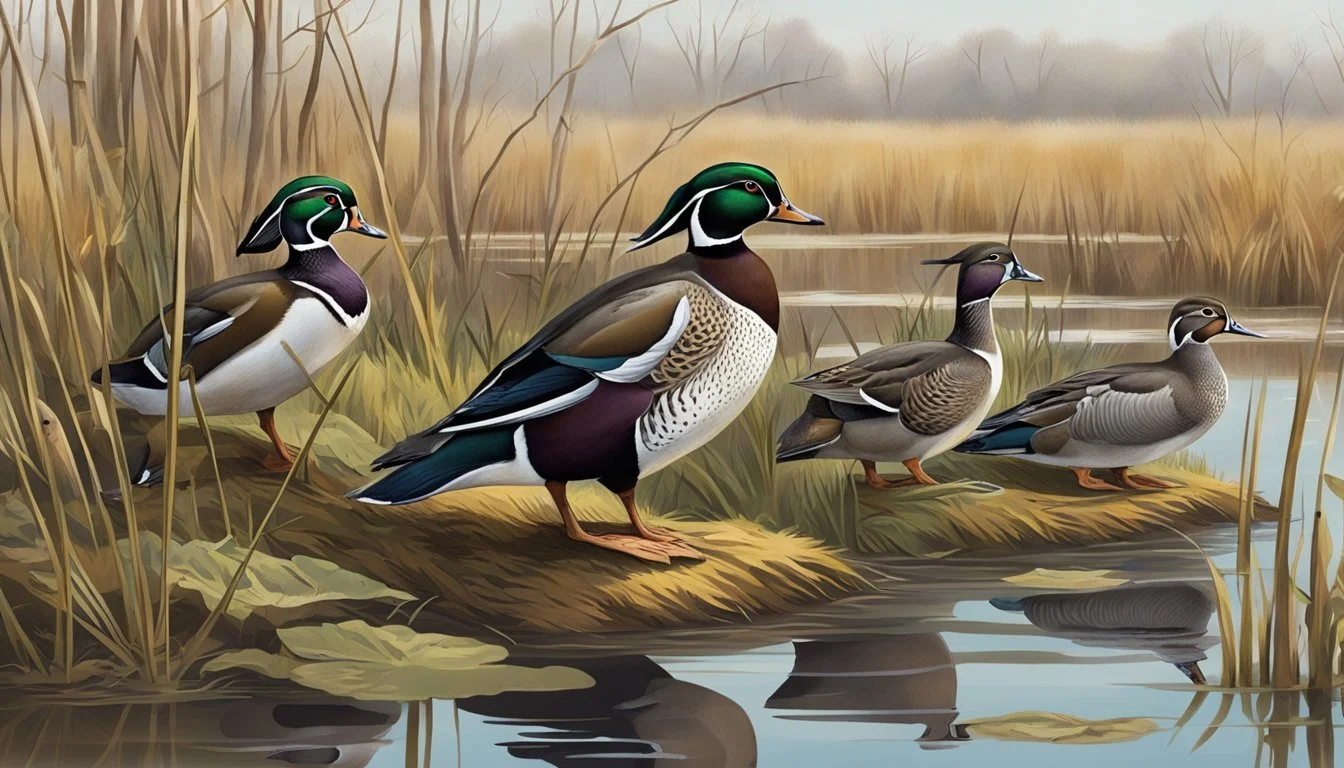Wood Duck Hunting Seasons
Regulations and Optimal Times
This Article is Part of Our Guide on Hunting Seasons for Over 70 Common Game Species
Wood duck hunting is a cherished tradition for many waterfowl enthusiasts, offering a unique blend of challenge and reward. Wood ducks are known for their striking plumage and acrobatic flight patterns, making them a sought-after species among hunters. These ducks inhabit wooded swamps and marshes, preferring areas with ample cover such as flooded timber and forested wetlands. Their elusive nature requires hunters to employ strategic thinking and precise tactics to successfully harvest them.
As the hunting seasons roll in, regulations are put in place to ensure sustainable hunting practices. Hunters must be mindful of the specific seasons that vary by state and region, often influenced by migration patterns and breeding cycles. It is essential for hunters to stay informed about current regulations, including bag limits and the legal hunting hours, to comply with conservation efforts. The use of wood duck boxes has also become a widespread conservation tool, aiding in the maintenance of healthy wood duck populations across their native range.
Acknowledging the balance between the sport and conservation, hunters partake in wood duck hunting with a sense of responsibility. They often engage in practices like the Mandatory Harvest Information Program (HIP) and adhere to the guidelines set by wildlife management plans. These measures ensure the sustainability of wood duck populations, providing opportunities for future generations of hunters to enjoy the pursuit of this remarkable species.
Understanding Wood Duck Behavior
To effectively hunt wood ducks, one must have a thorough understanding of their specific behaviors, notably their feeding habits and migratory patterns. These attributes are pivotal for locating and identifying the optimal conditions for hunting wood ducks.
Feeding Habits
Wood ducks are distinctive in their dietary preferences, and their feeding habits are highly influenced by the availability of their favored food sources. They are predominantly granivorous, with a strong preference for nuts (how long do nuts last?) and grains. Unlike other duck species that may feed on a diverse range of aquatic plants and insects, wood ducks show a particular affinity for acorns and similarly pecans (how long do pecans last?), when accessible. In fact, during the winter months, acorns can constitute a significant portion of their diet. They are known to habituate areas abundant in these foods, often in backwater swamps and riverine systems.
Primary food source: Nuts (especially acorns and pecans)
Secondary food sources: Seeds, fruits, aquatic plants
Migratory Patterns
As migratory birds, wood ducks showcase specific seasonal movements that are crucial to understand for hunting purposes. They breed in various regions across North America, favoring wooded swamps, shallow lakes, and slow-moving rivers. They generally migrate in response to weather conditions and food availability, moving from their northern breeding grounds to more temperate southern regions during the fall. Recognizing their migratory habits aids hunters in predicting when wood ducks will be present in their local habitats.
Breeding Habitat: Wooded swamps, marshes, and other water-rich environments
Migration: Spring northward return; fall retreat to warmer southern areas
Hunting Regulations
In regulating wood duck hunting, the primary factors are the preservation of the species and the provision of equitable hunting opportunities. The United States Fish and Wildlife Service (USFWS) plays a central role in setting the framework for seasons and bag limits, considering population status and harvest trends as part of the adaptive harvest management strategy to ensure sustainable hunting.
Seasonal Timeframes
Early Season: Special early seasons may exist for certain waterfowl like teal and wood ducks. These are set to occur before the general hunting seasons and are designed to balance hunter opportunity with the conservation of the species.
General Season: The main wood duck hunting season dates vary by state, typically falling within a time frame established by the USFWS. The Migratory Bird Treaty Act (MBTA) influences these dates to ensure they are consistent with migratory patterns.
States must work within federal guidelines but may adjust season dates for regional considerations. It is the hunters' responsibility to be aware of their state's specific season dates for wood duck hunting.
Legal Bag Limits
Daily Limits: The USFWS establishes daily bag limits based on population assessments. Typically, these limits may include 2-3 wood ducks per day, but variations can occur by state and yearly trends.
Seasonal Limits: Some states may implement additional controls such as seasonal or possession limits to further regulate harvests and protect local populations.
The exact bag limits are determined yearly through the adaptive harvest management strategy, which takes into account current research on population dynamics and trends. Hunters need to check with their state regulations each season to stay compliant with these limits.
Preparation for Duck Season
To ensure a successful wood duck hunting season, hunters need to focus on precise scouting, choosing appropriate gear, mastering calls, and understanding legal shooting times. These foundational steps can significantly increase the chances of a rewarding hunt.
Scouting for Success
Before the hunting season begins, scouting is crucial to locate prime wood duck habitats. Scouting helps a hunter understand the daily patterns of wood ducks, such as their feeding and resting areas. Ideal locations include flooded timber, marsh edges near forests, and creeks within dense woods. Hunters should look for signs of wood duck presence, like droppings and feathers, and note these in a scouting journal for future reference.
Selecting Proper Gear
A hunter needs to select the right gear to blend into the environment and improve the odds of a successful hunt. Essential items include:
Camouflage clothing: Full camo gear helps hunters remain undetected.
Decoys: A small set of 3-4 decoys can suffice to attract wood ducks.
Shotgun: A reliable shotgun with an improved cylinder choke is ideal for the quick flights of wood ducks.
Ammunition: High-quality loads designed for waterfowl are necessary for an ethical hunt.
Practicing Calls
Using duck calls effectively can greatly improve a hunter's success rate. The sounds of calls need to mimic the wood duck's actual calls to be convincing. Hunters should practice regularly before the season to ensure they can produce realistic and enticing calls.
Understanding Shooting Light
Shooting light times vary and are generally linked to legal hunting hours—usually from half an hour before sunrise to half an hour after sunset. Hunters must be aware of these times to stay compliant with hunting regulations. They should also practice shooting during these light conditions to adjust to the lower visibility levels that occur during dawn and dusk.
Setting up for Hunting
Setting up for a successful wood duck hunt involves crucial preparation in decoy spreads, choosing the best hunting spots, and using effective concealment. These strategies are key for enticing wood ducks and achieving a fruitful hunting experience.
Effective Decoy Placement
Decoys serve as a visual lure for wood ducks, making strategic placement essential. Hunters should set their decoys in small groups, mimicking natural behavior. Since wood ducks are known for dropping into beaver ponds and small backwaters with heavy cover, placing decoys among stumps or near the edge of farm ponds can be particularly effective.
Spacing: Leave adequate space between decoys to appear natural.
Numbers: A dozen decoys are often sufficient.
Movement: Add motion decoys to simulate feeding ducks.
Strategic Location Choice
The location is paramount when setting up for wood duck hunting. Hunters need to put boots on the ground and scout for areas where wood ducks are prevalent. Ideal locations often include beaver ponds, farm ponds, and sheltered backwaters rich in aquatic vegetation and insects.
Beaver Ponds:
Look for signs of beaver activity.
Provides natural cover and food sources.
Farm Ponds and Backwaters:
Generally less pressured.
Monitor these spots for wood duck activity before hunting season.
Concealment Techniques
Wood ducks are wary and have keen eyesight; thus, proper camouflage plays a significant role in a hunter's ability to remain undetected.
Clothing: Wear camo patterns matching the local environment.
Blinds: Use natural materials to build blinds that blend in with the surroundings.
Stillness: Minimize movements when ducks are approaching or overhead.
Using subtle duck sounds and mastering calling wood ducks without overdoing it can attract birds without alarming them. Familiarity with wood duck sounds and replicating them can enhance the chances of a successful hunt.
In-Field Hunting Strategies
Wood duck hunting requires a mix of stealth, strategic decoy placement, and understanding of the terrain. These in-field hunting strategies, when applied correctly, can significantly enhance a hunter's success rate with this agile and swift species.
Decoying for Wood Ducks
For effective wood duck decoying, hunters should deploy a modest spread of decoys in a place that wood ducks frequent, such as in sloughs or near a beaver dam. Since wood ducks can be wary, a mix of drake and hen decoys can present a natural look. Adding a spinner to the spread may increase visibility and induce passing ducks to take a closer look.
Jump Shooting Technique
Jump shooting wood ducks is a dynamic hunting method that involves stealthily approaching duck-populated waters and flushing them into flight before taking a shot. Hunters should move quietly along creek banks and near wooded ponds, staying concealed until in range. This strategy requires precise timing and a quick, accurate shot with a shotgun.
Using Natural Topography
Natural topography can be used to a hunter's advantage. Structures such as fallen timber or thick underbrush provide natural hiding spots for setting up close to a roost or feeding area without being detected. Hunters should use their knowledge of the terrain and wind direction to position themselves for optimal shooting opportunities. Utilizing the topography can also assist in directing ducks towards the decoy spread.
Remember, regardless of the strategy, always ensure the shotgun is loaded with the appropriate load and choke for wood duck hunting to maintain the balance between range and pattern density for effective shooting.
Identification and Conservation
The section offers insights into recognizing the wood duck species and underscores the importance of promoting habitat preservation to ensure sustainable hunting practices and conservation of the species.
Recognizing Wood Duck Species
The wood duck, scientifically known as Aix sponsa, is notable for its striking appearance. Identifying them requires an understanding of their distinct sexual dimorphism. Male wood ducks, or drakes, boast iridescent green and purple heads, white throat patches, and chestnut-brown chests. Females, on the other hand, display mottled brown plumage which provides camouflage. Both males and females possess muted yellow legs and brownish black wings with a dark blue wing patch—known as the speculum—edged in white.
Promoting Habitat Preservation
Conservation of wood ducks involves proactive habitat management. Since wood ducks are migratory birds that use the Atlantic, Mississippi, Pacific, and Central Flyways, preserving wetlands across these regions is crucial. Nest boxes have become a vital tool in wood duck conservation, countering the scarcity of natural nesting sites. Additionally, maintaining and protecting beaver ponds provides ideal habitats, as these areas offer food and shelter, enhancing the wood ducks' survival rates. Careful monitoring of duck harvests is integral to conservation efforts, ensuring that populations remain robust and hunting remains sustainable.
Post-Hunt Practices
After a successful hunt, ethical considerations and habitat preservation are crucial to ensure sustainable wood duck populations and conservation of all migratory bird species, such as teal, mallard, pintails, and bluebills.
Responsible Game Handling
Proper game handling is imperative for every hunter. Once a wood duck is harvested, the hunter should swiftly and respectfully retrieve the bird. This minimizes any unnecessary suffering and respects the value of the life taken. Hunters should also accurately identify their harvest to avoid surpassing bag limits, which are in place to protect the wood duck and other duck populations.
It's important to process the game as soon as possible to maintain the quality of the meat. Here's a simplified guide for handling the game post-hunt:
Retrieval: Approach downed wood ducks quickly to ensure they are dispatched humanely.
Identification: Confirm the species is a wood duck to stay within legal hunting regulations.
Inspection: Examine the bird for any signs of disease or abnormalities.
Cleaning: Begin the cleaning process to preserve meat quality, following these steps:
Pluck feathers.
Remove innards.
Clean the carcass with fresh water.
Storage: Store the game meat at cool temperatures to prevent spoilage.
Environmental Considerations
Hunting impacts more than just targeted species; decoys, spent cartridges, and other hunting equipment can affect the natural environment if left behind. Hunters should collect all their belongings, including any non-biodegradable items, to minimize their ecological footprint. By maintaining clean habitats, hunters support not only the wood ducks but also the entire ecosystem which includes mallards, teal, and other migratory bird species.
To safeguard the environment, hunters can follow these guidelines:
Decoy Retrieval: Pick up all decoys after the hunt, as they can be misleading to live ducks and other wildlife.
Litter Control: Remove all shells, packaging, and any trash produced during the hunt.
Habitat Preservation: Avoid disturbing natural flora and fauna, and stay on designated paths to prevent habitat damage.
By adhering to these post-hunt practices, hunters contribute to the long-term health and viability of wood duck populations and ensure the sustainability of hunting for future generations.
The Culinary Aspect of Duck Hunting
Wood duck hunting not only offers the thrill of the chase but also provides a unique culinary opportunity. Known for their high-quality table fare, wood ducks present a gastronomic experience that those on the hunt are eager to bring from field to table.
Field to Table
Once a wood duck is harvested, proper field dressing is crucial. A waterfowl hunter typically uses a shotgun loaded with steel shot, often choosing no. 4 for its effectiveness. It's important to note that prompt and appropriate cleaning of the bird ensures the meat maintains its quality. Wood ducks are noted for their rich, full-flavored taste, making them a highly prized catch among waterfowl hunters seeking to extend their experience to the kitchen.
Cooking Techniques
To maximize the culinary appeal of wood duck, one should employ cooking methods that accentuate its natural flavors:
Roasting: Simple and traditional, roasting allows the natural flavors of the wood duck to shine. Cooking at a high temperature for shorter durations ensures a moist and tender meat interior with a crisp skin.
Grilling: A technique that is ideal for adding a smoky flavor and achieving a delicious char on the meat, which complements the wood duck’s richness.
Sous Vide: An approach for the modernist, sous vide cooking involves sealing the wood duck in a bag and cooking it in temperature-controlled water, resulting in perfectly cooked, tender meat.
Selecting the right cooking technique is crucial in transforming the harvested waterfowl into a succulent meal that honours the pursuit involved in duck hunting.





